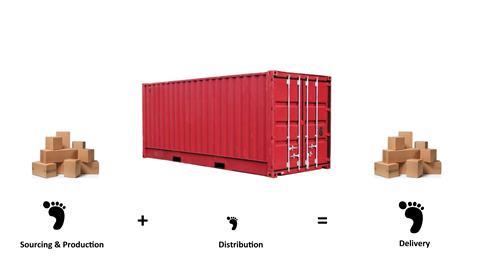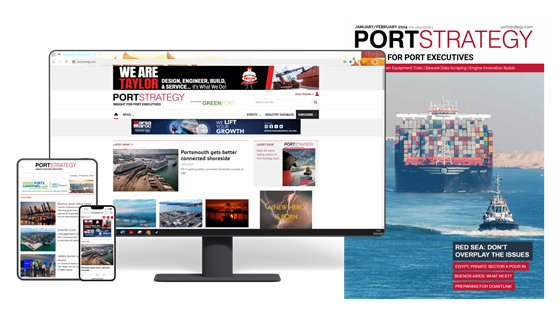Carbon footprinting of container terminals is not yet mandatory but recommended, writes Professor Jens Froese from the Global Logistics Emission Council (GLEC).

To minimise administration efforts and to base all energy consumption and greenhouse gas emissions recording on the same consistent operational database, an integrated approach to manage energy and capture carbon footprint in one management system is recommend.
Greenhouse gases
Greenhouse gases (GHG) are gases able to trap the heat in the atmosphere and hence responsible for global warming. Carbon dioxide (CO2) provides the biggest share, followed by methane, nitrous oxides and fluorinated gases. The global warming potential of carbon dioxide serves as a reference for the other greenhouse gases, expressed as a multiple of CO2 which is set “1”. To quantify emissions composed of a variety of greenhouse gases the CO2-equivalent (CO2e) is used. The GHG-emissions of eg a factory is called the factory’s carbon footprint.
A number of initiatives, eg the globally acting Carbon Trust, advocates carbon management across the supply chain thus meeting the interests of those who want to know the total carbon footprint of products they consume. Fourth party logistics providers (4PL) are taking the lead to account for the accumulated carbon footprint.
Container terminals
Measuring and reporting terminal GHG-emissions currently is not mandatory but recommended in the view of already existing and upcoming new carbon dioxide reporting standards. Some terminals have already developed systems to monitor emissions for internal use. Mandatory carbon footprint reporting is expected for the near future, which must be based on comparable conditions and methodologies. Pre-competitive co-operation and exchange of ideas therefore is essential.
Workload on container terminals is very high, so additional burdens from carbon footprint management system must be kept at a minimum. The terms of reference must include:
- identify unambiguous operational boundaries
- be comprehensive
- be consistent also with other management systems
- have the potential to be integrated with other management systems applied
- be transparent
- be benchmarking adequate
- have minimal administrational efforts
- be standardised.
Energy management system
Within the research project GREEN EFFORTS, 2012 – 2014, co-funded by the European Commission, a first approach along the above listed terms or reference was developed and put into practice. The rationale behind the GREEN EFFORTS methodology is to begin with monitoring of energy-efficiency according to ISO 50001 as carbon dioxide emissions on terminals are equivalent to energy consumption. ISO 50001 provides an energy management system (EnMS) to systematically record the energy consumption and to improve energy-efficiency.
The terminal site does not necessarily define the EnMS system boundaries as there also might be container freight stations, packing and labelling units, container repair workshops or coldstores. These business units must be monitored separately. The core terminal service, moving containers, includes container handling equipment, yard facilities (eg lighting, workshops, reefer stations) and buildings (offices, IT, social rooms as recreation rooms, canteens and showers). For facilities shared with other business units, an energy consumption allocation key must be developed.
Energy supplies include:
- Electric power from public grid
- diesel fuel
- electric power produced on-site (photovoltaics, wind turbines)
- combined power-heat (co-generation)
- liquefied natural gas (LNG)
- hydrogen
- methanol
- others (biogas, liquefied petrol gas, distant heating etc)
Currently, the majority of container terminals consume both, electric energy and diesel fuel, however, there is a tendency towards fully-electrified terminals mainly to support automation.
One can only manage what can be measured, however, it is not necessary to continuously measure process and equipment consumption in too much detail. A clustered approach combining logical process units is usually sufficient. A case where a more detailed view is required may be when comparing equipment consumption versus performance, where a temporary monitoring system can be set up.
Terminal carbon footprint
Quantification of GHG emissions from a terminal can be derived from the energy consumption provided by the EnMS. Conversion factors are used to calculate the amount of GHG emissions caused by energy use in kWh and measured in units of kilogramme carbon dioxide equivalent (kg CO2e).
ISO 14064-1 “Greenhouse gases” provides guidance how to determine the carbon footprint and “The Greenhouse Gas Protocol” provides additional helpful information.
Example:
A medium-sized European container terminal (1.5 million TEU/annum) for 2014 reported the following energy consumptions:
- electric power total 11.800.000 kWh
- diesel fuel total 3.090.000 litres≙ 30.900.000 kWh
The relevant conversion factors are:
- for electric power supply 0.529 kg CO2e/kWh
- for diesel fuel 0.264 kg CO2e/kWh
Resulting terminal carbon footprint:
from electric power 11.800.000 kWh x 0.529 kg CO2e/kWh = 6.242.200 kg CO2e
from diesel fuel 30.900.000 kWh x 0.264 CO2e/kWh = 8.157.600 kg CO2e
Total 14.399.800 kg CO2e
In the case of emissions of other greenhouse gases (eg methane from LNG-fuels, fluorinated gases from refrigerants or electrical insulations), the quantities must be captured, converted to CO2 equivalents and added to the carbon footprint from energy consumption to provide the total carbon footprint.
This is a rather simple approach. The issue becomes sophisticated when allocation to reference units is necessary, as required by some clients and laid down in the standard CEN EN 16258 describing allocation methods for transport, however this is currently restricted to vehicles (truck, ship, airplane, railway). Transhipment and cargo distribution centres are not yet included but shall follow soon.
Identification of reference units and adequate allocation of carbon footprint per reference unit raises some crucial questions:
- For a container terminal it seems logical to use a container (box) as reference unit. However, 4PL-providers request “tonne” (1.000 kg) as a reference unit to achieve compatibility to methods applied for the transport chains. Container terminals prefer TEU as a reference unit matching their statistics. As the share between 20’, 40’/45’-boxes varies from terminal to terminal it is possible they can be reported together using the TEU-factor. Multiplication of number of containers by TEU-factor results in TEU.
- Counting of containers. It is important that the real throughput of boxes is counted and any box only counted once. Currently throughput is calculated according to local standards and regulations and hence does not serve for comparison. Development of an unambiguous box counting system is required.
- Impact of container weight. The few available results from measuring container weight versus handling consumption shows that the weight differences do not very much influence the consumption, however, more research is required, to either prove these findings or to allow identification of container weight classes. If it turns out that the box weight is of minor importance it should be investigated if alternatively to the reference unit “container” the unit “tonne” can become a reference unit to satisfy the 4PLproviders.
- Reefer containers. The electric consumption of reefer containers plugged in at the terminal can vary dramatically, mainly depending on commodities carried and ambient temperature. Reefers with deep frozen cargo show a relatively steady consumption, reefers with fruits and vegetables (chilled cargo), due to high air exchange rates to remove the ethylene (ripening gas), result in an extremely volatile consumption. Investigation is required to find out if equal allocation of the reefer consumption to all reefer boxes is acceptable or if consumption classes have to be determined.
Any method to allocate the carbon footprint to reference units, which always will be an averaged approach, must be reversible, ie summing up all product carbon footprints must again result in the total terminal carbon footprint.
The methodology briefly described will need to become refined with respect to accuracy and practicability. This requires experiencing available methodologies, compare results and exchange ideas. Initiatives such as the Global Logistics Emissions Council (GLEC) are providing platforms for further co-operation and harmonisation with other transport activities, research and policy development.
Inland logistics, multimodal solutions and traffic management will be covered in an in-depth session at the 10th GreenPort Congress. Presentations include 'The clean trucks Programme in the Ports of Los Angeles and Long Beach', 'Inland ports looking seaward and towards the hinterland for sustainable development' and 'Is the corridor approach of EU Commissions really target-aimed?'
The early bird delegate rate is currently available, but only for a limited time - book now to save 20%! Preferential rates are available for delegates attending both the GreenPort Cruise Conference and GreenPort Congress, sign up now and save more! For any other information, email congress@greenport.com or call the Events Team on +44 1329 825335.







